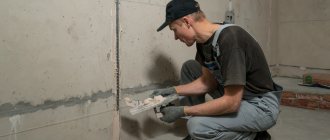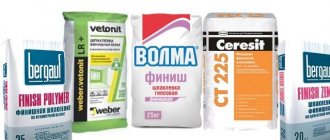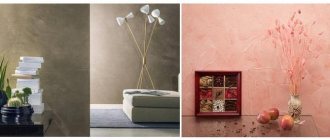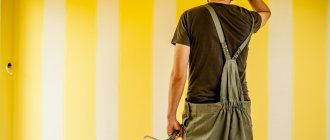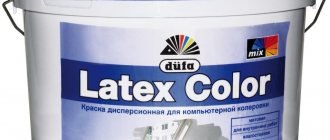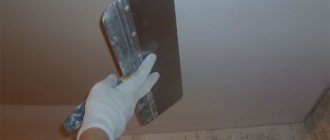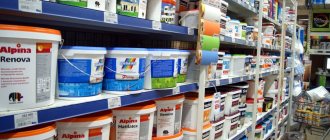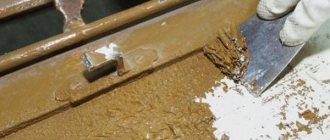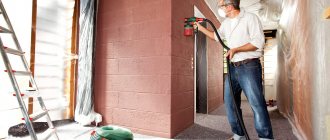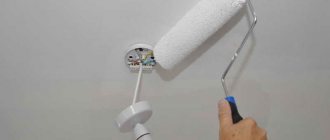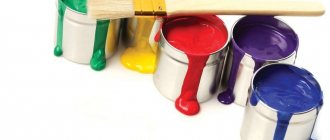11108 0 5
MesterulManole June 13, 2017Specialization: many years of experience in finishing works of residential and office premises, dachas, country cottages, etc. Hobby: cycling in all its forms
Do not rush to throw away damaged plastic body parts ahead of time, because they are easy to straighten
Don't know how to level a plastic surface before painting? I will tell you what and how to putty plastic in order to achieve a perfectly flat, durable surface. After reading the article, you can choose the appropriate composition and independently apply it for its intended purpose.
Material requirements
Plastic is a synthetic material with a glossy or matte surface. It has a lot of useful qualities for the consumer - it repels water and does not absorb it at all, and does not deteriorate from the action of oils, weak acids and alkalis. Plastic products are light, moderately flexible and plastic, and have an attractive appearance.
Among the negative properties of plastic it is worth noting:
- low hardness;
- low adhesion force to finishing materials;
- rapid abrasion and scratches.
To repair or restore a plastic item, you will have to get a special product, since conventional building compounds are not suitable for this purpose. Only the use of a special putty on plastic can return the product to its original appearance.
High-quality putty must meet a number of important requirements:
- high level of adhesion specifically with plastic surfaces that are very smooth;
- significant strength, resistance to all kinds of damaging factors;
- hardness after drying and the possibility of modification - sanding, painting;
- compatibility with special paints and varnishes for plastic.
High-quality mixtures are easy to use at home. They do not require expensive tools or special skills to apply. However, even the best putty does not always make it possible to “reanimate” a plastic product. If it is badly broken, a large section has been broken, or a network of cracks has spread over a large area, it is better to replace it with a new one.
Process Features
First, as usual, the surface is cleaned of dirt, stains and dust. After this, the area of deformation is ground, and burrs and fragments, if any, are removed. Then, most often, the plastic surface is degreased, which precedes the main work.
The prepared mass must be applied so that its layer is at least 3 mm.
Try to keep the coating as even as possible, so that you don’t have to work on processing later. Then wait until the composition dries, and if necessary, the surface is sanded.
So, usually putty for plastic is a two-component material that is applied with a spatula. A good putty will have high elasticity, excellent adhesion, and a hardener can be added to it before application.
Separately, it is worth mentioning the moment of adding the plasticizer. A plasticizer is a special composition that improves the performance of the mixture. And for putty, ease of working with it, and application, it is sometimes necessary.
What else is a plasticizer needed for?:
- It reduces water consumption;
- Gives resistance to temperature changes;
- Prevents water penetration;
- Provides resistance to cracking;
- Prevents the solution from separating.
In some cases, the plasticizer makes the process of laying the composition into molds easier.
Types of putties
Putty mixtures for repairing plastic vary depending on the purpose and composition of their components.
By method of application
The purposes for using various putties can vary greatly. According to this indicator, there is the following classification of funds:
- Filling. Contains coarse fillers. Designed to quickly fill a defect and create a new relief. The finished surface will not be smooth, so after applying the putty it must be further processed. It is almost impossible to sand the plastic to perfect smoothness after filling it.
- Finishing. These products can be called finishing agents. They contain fine-grained fillers, so they can be applied in an even, thin, smooth layer. As they harden, they can be sanded almost to a shine. The finished “patch” will be non-porous and dense, just like the plastic itself.
- Universal. The middle fraction fillers in the composition make such putties suitable for performing any operations with plastic. They can both fill defects and flaws, and level out worn bases. Such products are especially popular among auto repair specialists.
By composition
The plastic mass, which is putty on plastic, creates an almost flat, uniform surface with the base material. This is achieved by introducing special components into its composition. The main components of any material are:
- Binder. This is a whole group of bulk fillers that give the mass plasticity when applied and elasticity after drying. It is they who bind the entire composition into a single mass. Plasticizers and stabilizers must be added to the binders.
- Fillers. The putty base is represented by fillers of different fractions, which differ in type and grain size.
- Dyes. These substances are intended to give the putty mixture a certain color, which allows it not to contrast with the main surface.
Depending on the composition, all putties for plastic are divided into the following types:
- Acrylic. One-component products based on acrylates form a flat, smooth surface after drying. Acrylic-based mixtures are harmless, odorless, sold in finished form and do not require the combination of individual components. But their strength leaves much to be desired, as does the strength of adhesion to the base. In addition, such putties give greater shrinkage.
- Polyester. They are two-component mixtures that harden quickly (in 1-2 hours), after which they can be immediately processed. Due to their low tendency to shrink, polyester putties can be applied even in a fairly thick layer (up to 0.5 cm). The disadvantage is the presence of an unpleasant odor, which is caused by styrenes that are harmful to health.
- Epoxy. They are also two-component, consisting of a base (resin) and a hardener. The composition may also include bulk fillers. Like polyester putties, epoxy materials release toxic substances when dried, but then become harmless. You can only work with them in well-ventilated areas. The great advantage of the mixtures is their high strength, lack of shrinkage, and ease of processing. The disadvantage of epoxy putties is their high cost.
- Nitro putties. They are leveling mixtures. They contain a nitro binder and fillers (kaolin, talc and others). Funds on this basis are characterized by significant shrinkage. They are usually applied in several very thin layers.
Features of working with certain types of auto putties
The technology for applying putties with special fillers is somewhat different from standard work; this is due to certain characteristics of the material. Let's pay attention to the following points:
- Fiberglass putty is difficult to sand. It is not advisable to apply paint directly on it; an additional layer of finishing composition will be required. Therefore, polyester with glass fiber cannot be applied flush with the surface to be treated. Leave 1-2 mm for the finishing coat, which will hide all defects.
- But putty with the addition of aluminum powder fits perfectly and practically does not shrink. Therefore, it is laid flush with the surface. But you should not make an extra slide; after all, the material is also difficult to further process.
- Apply finishing compounds in as small a layer as possible. It is better to lay 2-3 layers. Don't try to solve all the bump problems in one go. The same is true for materials applied by spraying.
And one more point that is typical for all polyester putties without exception. Never sand the prepared surface using water.
Making your own putty
The cost of compositions for plastic can be quite high, so some craftsmen prefer to make them themselves.
Necessary materials
To make putty at home you need to prepare:
- a piece of polystyrene foam;
- mixing container;
- wooden stick;
- talc;
- acetone.
Cooking method
First, expand the polystyrene foam (foam) into pieces, the size of which fits into the container without any problems. Fill the foam with acetone on top, but do not add too much of it - just enough to hide the main part of the material. Leave the foam until dissolved, stirring the liquid periodically. A white precipitate will appear inside, which is quite dense. To make the putty dry faster, add a little talc to its composition. Afterwards, immediately apply the mixture to the damaged area on the plastic, otherwise it will quickly dry out and become unusable.
Polymer putty with fiberglass
Repairing a plastic part using putty
To seal cracks and defects on internal parts subject to loads and vibration, I recommend using reinforcing putties for plastic with fiberglass. The latex-based polymer composition is sold in ready-to-use form. Can be applied in a layer of 2 mm. The disadvantage is the impossibility of grinding and creating a smooth surface. The situation is corrected by the use of finishing compositions without additives.
After sanding, the surface of the putty that requires painting is coated with a mineral acrylic primer. You can speed up the drying of materials with a lamp. The temperature should not exceed 60 degrees. The minimum must be at least ten.
Related article: Do-it-yourself repair of wooden windows with double-glazed windows (photos and videos)
The advantages of reinforcing materials with glass fiber are the ability to bend with the part and high resistance to vibration and dynamic loads.
The procedure for puttingtying plastic
The application of putty must be carried out with strict adherence to technology, otherwise the “patch” will not last long.
Preparing the base
As preparatory measures, the damaged area on the plastic is cleaned of debris and dust, sanded with sandpaper, washed or otherwise removed from dust. Be sure to degrease the product, otherwise the adhesion strength to the putty will decrease. Next, dry the surface and proceed to the main stage.
Preparation of the solution
Many putties suitable for repairing plastic items are sold ready-made and do not require mixing. However, most durable epoxy or polyester resin products are sold in a two-part form. Immediately before work, combine the base and hardener in the proportions strictly specified by the manufacturer. Take exactly the amount of putty that will be used up, since the remainder will be spoiled after hardening.
Applying putty
The prepared putty is scooped up with a narrow spatula, and then proceed as follows:
- apply the material to the damaged plastic, level it well with a thin, uniform layer (usually up to 2 mm);
- allow the product to dry (for resin-based putties - for 1-2 hours);
- carefully clean the coating with 400-grit sandpaper, brush off the dust and apply a layer of primer suitable for the given putty;
- perform another layer of putty, act in a similar way;
- At the end of the work, the “patch” is primed.
Large defects are usually repaired with a combination of filler and finishing putty. First, take the filling material, apply it to a previously prepared base, and distribute it well over the surface. After the composition has hardened, grinding and double treatment with a primer are done. Then they apply finishing putty and sand it, then treat it with primer.
Sanding and painting
Final sanding allows the surface to be perfectly even. This is usually done with the finest sandpaper. Then the base is rubbed with a soft sponge using circular movements with gentle pressure. Next, you can apply paint of a suitable composition and color to the product.
It happens that the entire plastic item gets scratched. In such a situation, it is better to cover it entirely with putty, including treating undamaged areas. If there are large or deep dents on the surface, substances are additionally added to the putty to enhance elasticity. Otherwise, there is a risk of the composition peeling off during operation of the product.
DIY technology for applying putty to plastic
The technology for using compositions for plastic is almost no different from the use of conventional universal putty mixtures and therefore it will not be difficult to do it yourself. Before purchasing the necessary composition for restoring plastic elements of a car, conduct a visual inspection of the damaged surfaces and estimate the required volume of the composition.
Considering the fairly high cost of putties, this is an important step. Prepare tools for work: a rubber or plastic staple, devices for grouting and grinding. After this, you can begin to putty the plastic in this sequence.
| Process | Nuances of the working stage |
| Cleansing | Clean the surface of the plastic car parts being processed from dirt. |
| Cleaning the part | If the mixture is applied to bare plastic, the base must be removed from gloss using sandpaper. |
| Surface degreasing | Degrease the surface with a composition specially designed for this purpose. |
| Preparing the mixture | Combine the viscous mixture with the hardener in the required proportions and mix thoroughly. |
| Applying the product to the surface | Apply the composition to the defective area using a spatula. Using a spatula, level the layer. |
| Sanding the part | After the composition has dried, sand the surface first with coarse-grained sandpaper, then with fine-grained sandpaper. |
Information! After you have completed the simple steps described above, the plastic surface will be ready for final painting.
The best manufacturers
Usually in construction stores, putties for plastic are sold on a separate stand, and their selection is not very diverse. But in automotive departments such products are presented in a wider range. Here is a list of products from well-known manufacturers that are characterized by excellent quality:
- Plastic18. Automotive finishing putty, sold at an affordable price in 0.2 liter packs.
- Solid Flex. Polyester putty with plasticizer. Reliably fills small and medium-sized cracks in plastic, cures quickly (in 30 minutes), and does not spring back during grinding. Also suitable for strengthening solder joints and gluing plastic parts.
- APP Flex Poly-Plast. Contains polyester particles, characterized by excellent elasticity and high strength. Reliably adheres to any plastic. Not afraid of acids and alkalis.
- Bumper-FIX from NOVOL. It has an affordable price and high quality. Suitable for all types of plastics.
- MasticPlast from ROBERLO. It is a finishing material, made on the basis of polyester resin. Sold complete with hardener. Combines well with epoxy primers, which increase its strength.
A good putty for plastic is ideal for this material and adheres reliably to it. It does not deteriorate from shock loads, ultraviolet radiation and harmful environmental influences, therefore it is able to give plastic products a second life.
How to putty plastic (video)
source: //tvoyprorab.com/pravilnaya-shpaklevka-dlya-plastika
The construction market is full of new products, including a huge range of putty solutions. They have different characteristics, advantages, and are used in different areas. A product based on epoxy resin is considered important. Such solutions have found application on construction sites when performing various works.
Epoxy putty
Drying time of the material
The drying time of the putty is influenced by various factors. One of them is the impact on the coating of the environment. At excessively high air temperatures, rapid and uneven curing of the material occurs.
The optimal relative humidity for proper drying of surfaces is 50%. Ventilating the room without creating drafts can help speed up the process of uniform curing of solutions. Other factors include:
- layer thickness;
- type of mixture.
The drying time of the putty is affected by the temperature and humidity in the room.
The standard indicator for surface drying time is considered to be 4 hours for polymer putty with a layer thickness of 1 mm. Complete curing of the material occurs after 24-48 hours. This process can be accelerated by using quick-drying compounds for finishing.
Advantages and disadvantages
Polymer compositions have many advantages. They have good adhesion, have increased moisture resistance, are plastic and are not afraid of temperature changes. Other advantages of the material include:
- no unpleasant odor;
- “breathable” structure;
- resistance to aggressive environments and deformation during drying;
- fast and uniform drying.
No cracks form on surfaces treated with this type of composition. The material is environmentally friendly, has increased strength and can retain its properties when diluted for up to 12 hours. The finishing putty does not crumble and is not destroyed for a long time.
Polymer putty does not form cracks, does not crumble, and is easily applied to a variety of surfaces
The plasticity of polymer materials makes it easy to distribute them over various surfaces in an even layer. When applying the solution to walls or ceilings, it does not form streaks or roughness.
The disadvantages of the compositions include their poor adhesion to wooden and metal surfaces, as well as the high cost of the material.
Tips and tricks for using putties
When working with polymer putties, experts recommend following a number of rules:
- To prepare solutions from dry mixtures, you must use only clean, warm water.
- The primer must be applied to the surface so as not to leave “bald patches”.
- Before use, the finished mixtures are thoroughly mixed, left to stand for 10-15 minutes and mixed again.
- Finishing of bases with putty is carried out only with compounds recommended by manufacturers for a certain type of surface: cement, gypsum, etc.
The finished compositions are thoroughly mixed several times before use.
If the surface has a large relief, the starting putty must be leveled only using a rule with a built-in level.
6th position. CHAMAELEON putty for plastics + hardener
CHAMAELEON car bumper repair putty is used when repairing plastic surfaces. The two-component composition effectively fills minor scratches and other damage.
CHAMAELEON putty for plastics + hardener
| Characteristics | |
| Blend color | Black |
| Type | Auto putty |
| Chem. compound | Polyester |
| Minimum application temperature | +10 °C |
| A country | Germany |
The composition can be used on almost all types of plastics. The putty is easy to process due to its elastic and soft structure. The mixture is environmentally friendly. The finished coating cannot be sanded wet.
Before application, you need to wash the surface to be treated with soap and wipe dry, and then degrease. Blow off any dust remaining after sanding using compressed air. Degrease the treated surface again. Before application, the material must be kept at room temperature. Apply the putty slowly to avoid air bubbles. Prime the surface before further painting.
